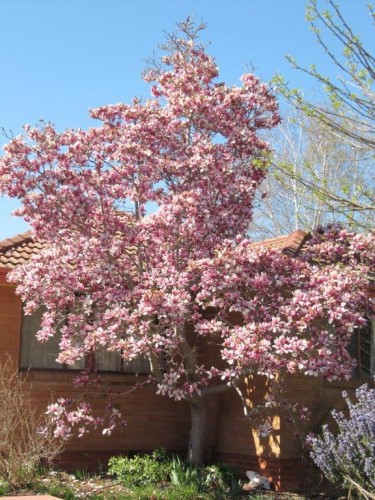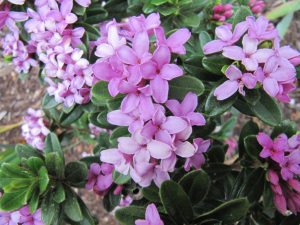
soulangeana… but did you notice how close it is to the house?
The magnolia family is very large. I have more than 100 varieties on my list that are mainly deciduous shrubs, from China and the Himalaya and can grow to tree size.
The only evergreen magnolia comes from Bull Bay in Carolina, US, hence its common name Magnolia “Bull Bay”, no relation to Laurus nobilis or bay tree.
Incidentally, recent queries regarding the bronze colour on the back of the leaf were concerned it was disease such as rust, but is actually one of the beauties of this tree, combined with the dark green, glossy leaves and huge saucer-size, creamy-white flowers.
But take a closer look at the M. soulangeana. At first glance, the floral display will wow you, but did you notice how close it is to the house?
This tree was obviously planted many years ago and seemed ideal to plant in the corner of the building. Now, with a trunk 40cm across and still growing, it could cause structural damage to the house, which has had several owners since 1964 and no-one knows who planted it. Each new owner has left it there to get bigger and bigger.
In addition, the plant’s roots can present major problems with all the building’s sewer pipes being the original earthenware type.
Unfortunately, at some stage this magnolia will have to be removed, a reminder that, when buying trees and shrubs, allow sufficient space for plants to grow and know where the underground services are, especially sewer pipes.
THERE is great excitement in the Bryant garden. One very small Daphne collina I have been nurturing for two years from barely 10 centimetres tall to its present 40cm has, this week, burst into flower for the first time.
This daphne is a taxonomic mystery. It is one of the Mediterranean daphnes as opposed to the Chinese daphne, such as Daphne odora.
It was first described by J.E. Smith when he saw it growing in southern Italy in 1792. But since then, this daphne is known only to grow in gardens and has never been found in the wild. Notwithstanding this mystery, it is an outstanding plant. Maybe a little hard to find, but if you see it, buy it.

The fragrance of a group of three Daphne “Eternal Fragrance” is wafting through the garden. This was bred in England and is a cross between D. collina and D. caucasica. Plant Growers Australia grow this here and market it through most garden centres.
SOME crazy person suggested recently in this column “the pullovers are off and everything is growing in the garden”! Slightly premature, as I write this the rain comes tumbling down and pullovers are back on. But what beautiful rain and so badly needed.
So, this week in the garden:
- Get ahead of the weeds, so easy to remove when the ground is moist.
- Rake lawns with a strong metal fork and sow grass seed to repair bare patches.
- Tie in rapid new growth of clematis and other climbers to support wires.
- As the days warm, look out for aphids on new growth. Hose off with a strong jet of water or spray with organic Pyrethrum.
- After this rain, keep the pet-safer Multiguard Snail and Slug Killer on hand for those critters emerging from their winter hibernation.
Who can be trusted?
In a world of spin and confusion, there’s never been a more important time to support independent journalism in Canberra.
If you trust our work online and want to enforce the power of independent voices, I invite you to make a small contribution.
Every dollar of support is invested back into our journalism to help keep citynews.com.au strong and free.
Thank you,
Ian Meikle, editor




Leave a Reply